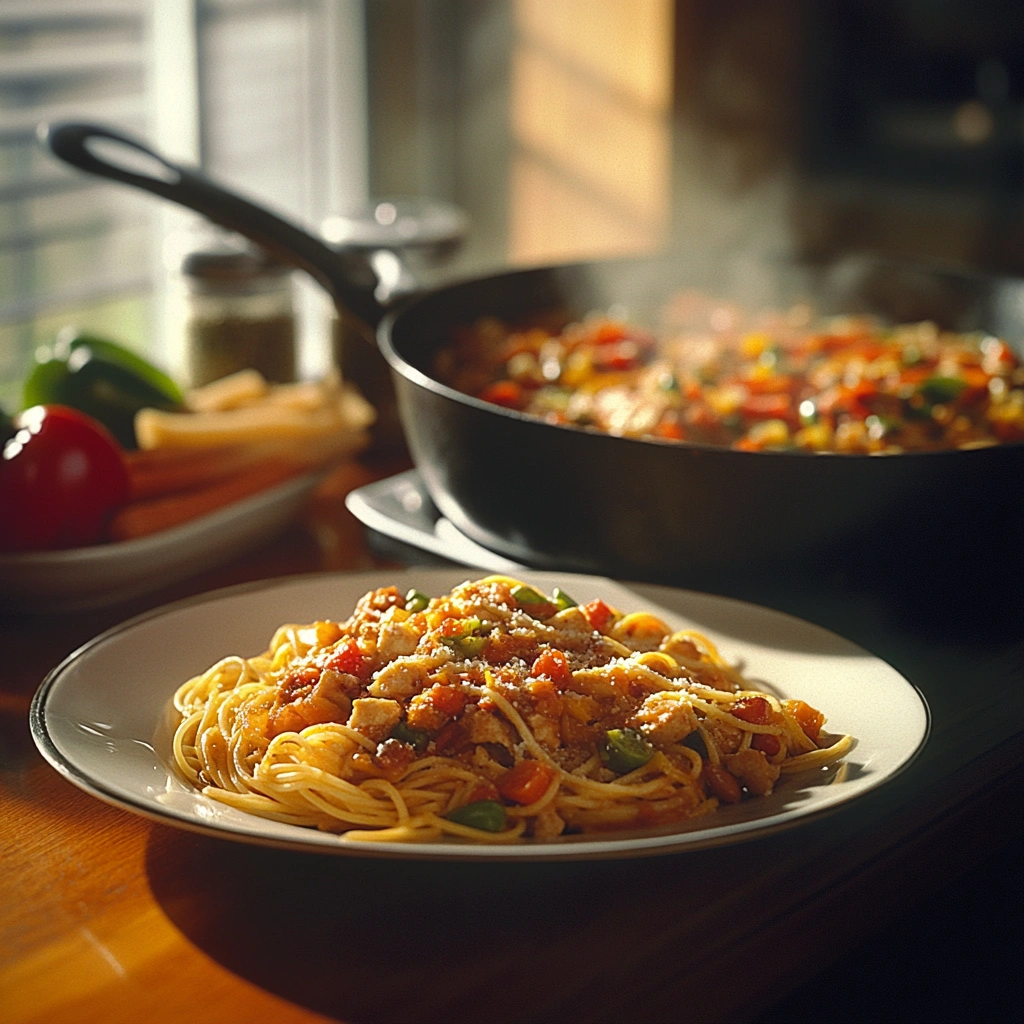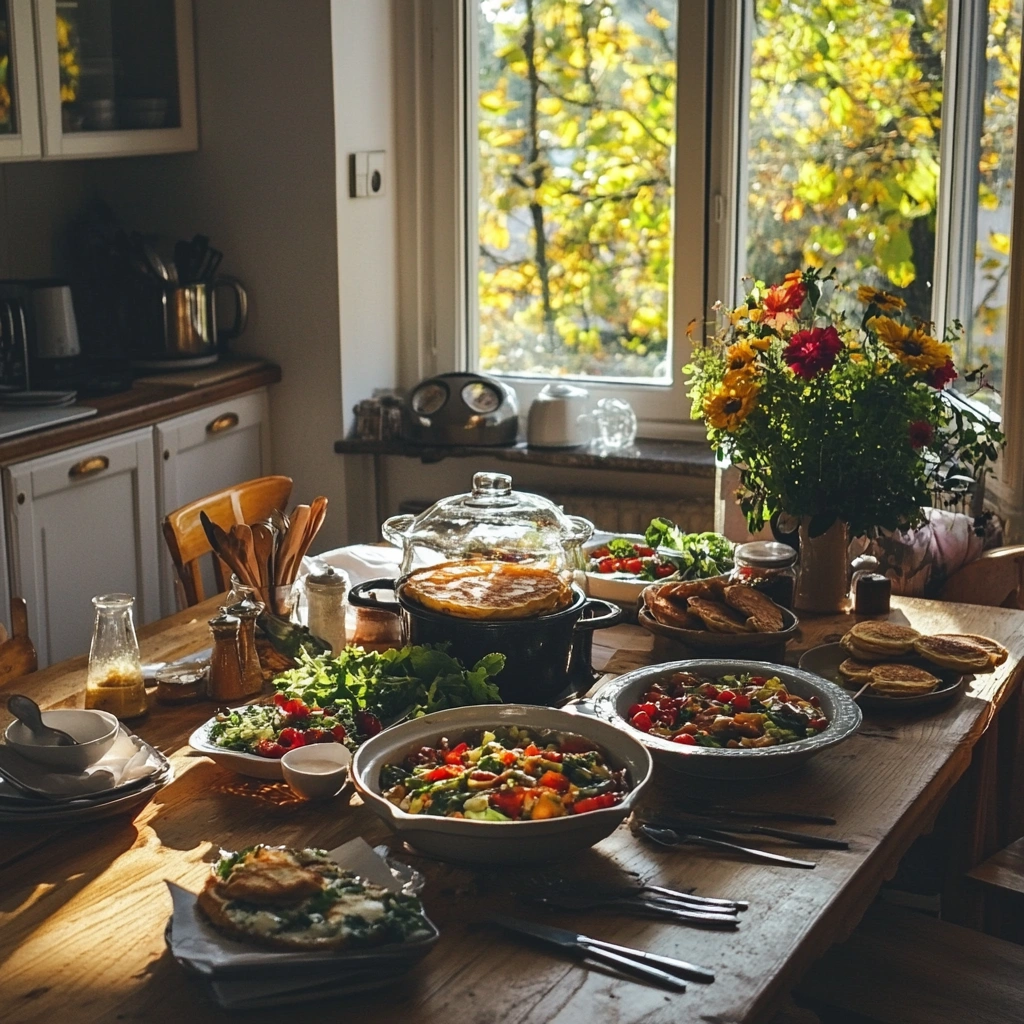What Homemade Food Can I Make?
Home-cooked meals hold a special charm, offering warmth, nourishment, and the joy of creating something delightful with your hands. Whether you’re an experienced cook or a beginner dipping your toes into the world of homemade cuisine, this article guides you through a variety of ideas. From breakfasts to dinners, this comprehensive guide ensures you’ll find recipes that suit your taste, budget, and skill level. Let’s start by understanding the basics that make home cooking truly special.
Part 1: Introduction to Homemade Cooking
Benefits of Cooking at Home
Cooking at home isn’t just a trend; it’s a lifestyle choice that offers numerous advantages. First and foremost, homemade meals are healthier because you control the ingredients. You can skip excess salt, sugar, and processed additives, tailoring each dish to your nutritional needs.
It’s also more economical—your favorite comfort foods often cost a fraction of their restaurant counterparts when made at home. And don’t overlook the joy of sharing food you’ve cooked with friends or family—it fosters connection and makes memories. Beyond all this, cooking is a skill that lets you unleash your creativity.
Essential Kitchen Tools for Beginners
To embark on your home-cooking journey, a few basic tools can make the process smoother. Start with a sharp chef’s knife—your most important ally in slicing and dicing. A durable cutting board, preferably wooden or plastic, will protect your countertops and make cleanup a breeze.
Next, invest in a versatile non-stick frying pan and a medium-sized pot for simmering soups or boiling pasta. Other essentials include measuring cups, a whisk, and a spatula. Don’t forget a trusty oven-safe dish for baked recipes. Having these tools ready equips you for any recipe, making cooking enjoyable instead of daunting.
Part 2: Easy Homemade Breakfast Ideas
Breakfast, often hailed as the most important meal of the day, sets the tone for your energy and focus. Whether you prefer a hearty start or a quick, on-the-go option, these homemade breakfast recipes will spark your creativity. Plus, they’re easy to prepare, making them perfect even for the busiest mornings.

Classic Pancakes
Who doesn’t love a stack of warm, fluffy pancakes? They’re a breakfast staple, and making them from scratch is simpler than you might think. All you need are basic pantry ingredients: flour, eggs, milk, baking powder, and a pinch of salt.
To prepare, whisk the dry and wet ingredients separately, then combine them gently to avoid overmixing—the key to fluffy pancakes! Cook on a greased pan over medium heat until golden brown. Serve with maple syrup, fresh fruits, or a dollop of yogurt for a wholesome twist. The best part? You can customize them with chocolate chips, blueberries, or even a sprinkle of cinnamon.
Vegetable Omelette
An omelette is a protein-packed breakfast that can be as simple or elaborate as you like. Start by whisking a couple of eggs with a splash of milk and a pinch of salt and pepper. Meanwhile, chop your favorite vegetables—onions, bell peppers, spinach, and mushrooms are classic choices.
Heat a non-stick skillet with a drizzle of oil or butter. Sauté the veggies until tender, then pour in the egg mixture. Cook until the edges set, then fold the omelette gently in half. This versatile dish is a blank canvas; add cheese, herbs, or even leftover roasted vegetables to make it your own.
Overnight Oats
If mornings are rushed, overnight oats are a lifesaver. Not only are they nutrient-rich and filling, but they also require no cooking. Simply combine rolled oats with milk or a dairy-free alternative in a jar. Add a spoonful of yogurt for creaminess, a drizzle of honey for sweetness, and a pinch of cinnamon for flavor.
The magic happens overnight in the fridge as the oats absorb the liquid, softening to a delightful texture. In the morning, top with fresh fruits like bananas or berries, a handful of nuts for crunch, or even a swirl of peanut butter. With endless topping options, overnight oats never get boring.
Avocado Toast
Avocado toast is a trendy yet timeless breakfast that’s both quick and satisfying. Start with a slice of whole-grain bread toasted to your preferred crispness. Meanwhile, mash a ripe avocado with a squeeze of lemon juice, salt, and pepper. Spread the mixture onto your toast and get creative with toppings.
Popular additions include a poached or fried egg, cherry tomatoes, or a sprinkle of chili flakes for heat. For an extra touch of indulgence, add a sprinkle of feta cheese or a drizzle of olive oil. It’s a balanced breakfast loaded with healthy fats, fiber, and flavor.
Smoothie Bowls
Smoothie bowls are as vibrant as they are nourishing. To make one, blend frozen fruits like bananas and berries with a splash of milk until smooth. The trick is to use less liquid than you would for a traditional smoothie to create a thick, spoonable consistency.
Pour the mixture into a bowl and unleash your artistic side by layering toppings. Fresh fruits, granola, shredded coconut, or chia seeds not only enhance the flavor but also add texture and visual appeal. This refreshing breakfast is perfect for hot mornings or when you crave something light yet fulfilling.
Why Homemade Breakfasts Matter
Preparing breakfast at home isn’t just about saving time or money—it’s about starting your day with intention. When you cook at home, you can ensure your meal is balanced and tailored to your preferences. Homemade breakfasts are free of artificial additives often found in pre-packaged options, making them a healthier choice for you and your family.
By experimenting with these recipes, you’ll discover that breakfast doesn’t have to be repetitive or boring. A little creativity and planning go a long way in transforming the morning rush into a moment of culinary joy.
Part 3: Simple Lunch Recipes
Lunchtime is the perfect opportunity to refuel your body with a balanced and satisfying meal. With homemade options, you can customize your lunch to suit your preferences, dietary needs, and budget. These simple lunch recipes are not only delicious but also quick to prepare, making them ideal for busy weekdays or a leisurely weekend bite.
Grilled Cheese Sandwich
The grilled cheese sandwich is a timeless classic loved by all ages. What makes it even better? It’s easy to whip up with just a handful of ingredients. Start with two slices of bread, buttering one side of each. Layer your favorite cheese—cheddar, mozzarella, or a mix—between the slices, with the buttered sides facing out.
Cook the sandwich in a preheated skillet over medium heat, pressing gently with a spatula for even toasting. Flip when the bottom is golden brown, and cook until the cheese melts to gooey perfection. Pair it with a bowl of homemade tomato soup for a comforting, restaurant-quality lunch.
Caesar Salad
A homemade Caesar salad is a light yet flavorful lunch that feels indulgent but is surprisingly simple to prepare. Start with fresh romaine lettuce, washed and chopped into bite-sized pieces. For the dressing, whisk together mayonnaise, Dijon mustard, minced garlic, lemon juice, and a splash of olive oil. Add grated Parmesan cheese and season with salt and pepper for a rich, creamy finish.
Toss the lettuce with the dressing, then top with croutons and additional Parmesan shavings. You can elevate the dish by adding grilled chicken, shrimp, or roasted chickpeas for a protein boost. This crowd-pleaser is perfect for those who crave a mix of crunch and zest.
Tomato Basil Soup
There’s nothing quite as comforting as a bowl of warm tomato soup, especially when it’s homemade. To make it, sauté diced onions and garlic in olive oil until fragrant. Add canned or fresh tomatoes, vegetable stock, and a handful of fresh basil leaves. Simmer for about 20 minutes to let the flavors meld together.
Blend the mixture until smooth, either using an immersion blender or transferring it to a countertop blender. Season with salt, pepper, and a touch of sugar to balance the acidity. Serve with a dollop of cream or a sprinkle of Parmesan for an added layer of indulgence. Pair this soup with crusty bread or the aforementioned grilled cheese sandwich for a winning combination.
Vegetable Wraps
Wraps are a versatile lunch option that can be tailored to whatever ingredients you have on hand. Start with a large tortilla or flatbread as the base. Spread hummus, cream cheese, or a tangy yogurt sauce for flavor. Add layers of fresh vegetables such as lettuce, spinach, cucumbers, shredded carrots, and bell peppers.
For protein, consider grilled chicken, black beans, or boiled eggs. Roll the wrap tightly, securing it with parchment paper or foil for easy eating. Not only are wraps portable and mess-free, but they’re also a great way to sneak in extra veggies during the day.
Why Choose Homemade Lunches?
Preparing lunch at home gives you full control over what goes on your plate. Unlike fast food or pre-packaged options, homemade meals are nutritious and satisfying. By trying these recipes, you can enjoy a variety of flavors without compromising your health or budget. Plus, they’re quick enough to fit into even the busiest schedules.
Part 4: Dinner Options for the Home Cook
Dinner is a time to unwind, gather with family, and savor a meal that leaves you satisfied. Homemade dinners are not only budget-friendly but also full of love and flavor, offering a way to reconnect after a long day. These recipes are simple to prepare, yet they pack a punch in taste and nutrition, ensuring everyone leaves the table happy.

Spaghetti Carbonara
Spaghetti Carbonara is a classic Italian dish that feels gourmet but is incredibly simple to make at home. Start by cooking spaghetti in salted boiling water until al dente. Meanwhile, whisk together eggs, grated Parmesan cheese, and a generous amount of black pepper in a bowl.
In a skillet, sauté minced garlic in olive oil until fragrant. Once the spaghetti is cooked, reserve a cup of pasta water before draining. Add the hot spaghetti to the skillet, removing it from heat to prevent the eggs from scrambling. Stir in the egg mixture, using reserved pasta water to achieve a creamy consistency. Garnish with more Parmesan and serve immediately. This dish is proof that comfort food can be quick and elegant.
Chicken Stir-Fry
For a healthy, flavorful dinner that’s ready in minutes, chicken stir-fry is a go-to recipe. Start by slicing chicken breast into bite-sized pieces and marinate it briefly with soy sauce, ginger, and garlic. While the chicken marinates, chop colorful vegetables such as bell peppers, broccoli, snap peas, and carrots.
Heat a wok or large skillet with a splash of oil, then cook the chicken until golden and cooked through. Remove it from the pan and stir-fry the vegetables until tender-crisp. Return the chicken to the pan, add a splash of soy sauce and sesame oil, and toss everything together. Serve over steamed rice or noodles for a complete, balanced meal.
Vegetarian Chili
For a hearty, plant-based dinner option, vegetarian chili is a winner. It’s packed with protein and fiber, making it as filling as it is delicious. Start by sautéing onions, garlic, and celery in a large pot until softened. Add diced tomatoes, kidney beans, black beans, and a mix of spices such as cumin, chili powder, and paprika.
Simmer the chili for 20–30 minutes, allowing the flavors to meld. For extra richness, you can stir in a spoonful of tomato paste or a splash of vegetable stock. Top the chili with diced avocado, shredded cheese, or a dollop of sour cream before serving. Pair it with cornbread or tortilla chips for a comforting, crowd-pleasing dinner.
Why Homemade Dinners Make a Difference
Homemade dinners are about more than just nourishment—they’re about creating moments. By cooking dinner at home, you ensure each meal reflects your family’s preferences and dietary needs. Plus, it’s a chance to unwind, experiment with new flavors, and even involve loved ones in the cooking process. The result? Dinners that are not just meals but memories.
FAQs About Homemade Food
When it comes to preparing homemade food, many questions arise, especially for beginners or those looking to try new recipes. Here are some commonly asked questions and their answers to help you master the art of home cooking.
What are some quick homemade meals?
Quick homemade meals don’t have to be boring! Dishes like vegetable stir-fry, grilled cheese sandwiches, or a hearty salad can be prepared in less than 20 minutes. Pasta dishes such as spaghetti aglio e olio are also great options, as they require minimal ingredients and effort. With a little meal prep, even tacos or wraps can become a fast yet satisfying dinner option.
How can I meal prep for the week?
Meal prepping involves preparing ingredients or fully cooked meals ahead of time to save time during the week. Start by planning your meals and making a shopping list. Cook large batches of versatile staples like rice, quinoa, or grilled chicken. Wash and chop vegetables to store in airtight containers, so they’re ready to use. Soups, casseroles, and pasta dishes freeze well, making them perfect for reheating on busy days.
What are budget-friendly homemade dishes?
Homemade meals are inherently cost-effective, but certain dishes stretch your budget even further. Lentil soups, rice and beans, vegetable stir-fries, and pasta dishes are economical yet satisfying. Using seasonal vegetables and pantry staples like canned tomatoes and dried spices can also keep costs low. With a little creativity, you can turn basic ingredients into gourmet-level dishes.
How do I make healthy homemade meals?
Healthy meals start with fresh, whole ingredients. Opt for lean proteins such as chicken, fish, or legumes, and pair them with whole grains like brown rice or quinoa. Incorporate a variety of colorful vegetables into every meal for a nutritional boost. Avoid processed foods and reduce salt and sugar in your recipes. Cooking methods like steaming, baking, or grilling enhance flavor while keeping meals light and nutritious.
What can I cook with limited ingredients?
Cooking with limited ingredients doesn’t have to be restrictive. Pasta with olive oil and garlic, scrambled eggs with toast, or vegetable soup made from leftover produce are all easy options. A few versatile pantry items—like canned beans, rice, and spices—can also help you create simple yet flavorful dishes. The key is to be resourceful and experiment with what’s on hand.
How can I make my food taste better?
The secret to delicious homemade food often lies in seasoning and balance. Use herbs and spices to enhance flavor, and don’t be afraid to taste as you go. Acids like lemon juice or vinegar can brighten up a dish, while a pinch of sugar can balance out acidity in tomato-based recipes. Experiment with textures by adding crunch, like nuts or croutons, to elevate your dishes.
Conclusion
Homemade food is more than just a practical solution for meals—it’s a journey into creativity, health, and connection. By exploring the variety of options from quick breakfasts to hearty dinners, you can transform ordinary ingredients into extraordinary experiences. Cooking at home empowers you to take charge of your diet, cater to your preferences, and save money, all while fostering a sense of accomplishment.
With the ideas and tips shared here, you’re equipped to tackle homemade cooking with confidence. Whether you’re experimenting with new recipes or perfecting your favorite dishes, the possibilities are endless. So, roll up your sleeves, embrace the joy of cooking, and savor the rewards of a meal made from scratch. Your kitchen is now your canvas—happy cooking!

